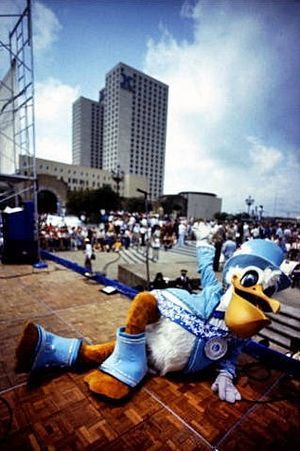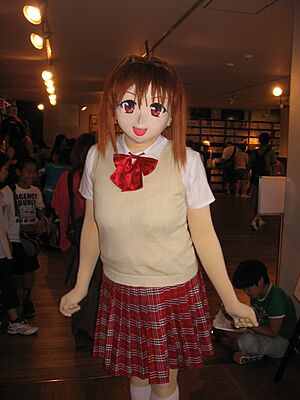Costumed character facts for kids
A costumed character is a person who wears a special outfit, often one that covers their face. These characters can be found in many places, like theme parks, where they walk around and meet visitors. They can also be mascots for sports teams, schools, or companies. Some costumes hide the person's face completely, while others, especially in theme parks, let the performer's face be seen.
Contents
Costumed Characters in Theme Parks
Costumed characters are a big part of fun places like Walt Disney Parks and Resorts and Universal Parks & Resorts. They help make the experience feel more magical by letting visitors meet and interact with characters they know from stories or movies.
People who work at these parks dress up as the characters. Some costumes are just clothes and makeup, like for a princess. Other costumes cover the whole person, like for a cartoon animal, and include a full head mask.
Theme parks usually have rules about these characters:
- Characters where you can see the performer's face (called "face" characters) are allowed to talk. They often follow special scripts.
- Characters where the face is covered (called "fur" characters) usually do not talk. They communicate using pantomime, which means they use gestures and body language. They might make a kissing sound!
It's interesting that sometimes very young children can get scared when they first see a costumed character. This often happens because the character looks much bigger in real life than they do on TV or in books!
Playing the Part: Being a Character
For characters based on famous stories, especially those who talk, theme park workers learn detailed scripts. These scripts help them answer questions from visitors, especially kids who might think the character is real. Performers practice these scripts to know their character's story very well. This helps them always act like the character.
At big theme parks, popular characters often have helpers. These helpers wear regular park uniforms. They assist with things like helping visitors, keeping everyone safe, and managing crowds. This way, the character performer doesn't have to stop acting like the character to deal with problems. If a performer needs a break, they give a secret signal. Their helper then tells visitors the character will be right back.
Theme parks have strict rules to make sure performers are never seen out of character. For costumes that cover the whole body, the performer is never seen "with their head off" by visitors. Also, two performers dressed as the same character are not supposed to be seen together by the public. This helps keep the magic alive!
Costumed Characters in Japan
In Japan, costumed performers are called kigurumi (着ぐるみ). This name comes from the Japanese words kiru (着る), meaning "to wear," and nuigurumi (ぬいぐるみ), meaning "stuffed toy." Japan has a strong kawaii (cute) culture, so mascots are very popular for promoting things.
Japanese mascots often look more chibi (a cute, small style) than Western mascots. They usually have a very large head that covers the performer's whole upper body. Their arms are often placed low on the body. Other mascots look more like anime characters.
Animegao
Animegao (アニメ顔), which means "anime face," is a type of kigurumi. It's used to look like anime or cartoon characters. The person's face is completely hidden by a special mask that looks like an anime face. The performer also wears clothes similar to the character's outfit.
Animegao costumes are used in professional stage shows and by cosplayers. These cosplayers are sometimes called "dollers." They make their own custom masks of different characters. While it's still a smaller part of the cosplay scene in Japan, it has become more popular in other countries like the United States and Canada since about 2005.
Costumed Characters on Television
Many TV shows feature costumed characters. Some are puppets, like Big Bird from Sesame Street and Barney from Barney and Friends. Other shows feature people in costumes, such as Hip Hop Harry and Yo Gabba Gabba!.
Older TV shows that had costumed characters include New Zoo Revue, H.R. Pufnstuf, and Banana Splits.
Unauthorized Costumed Characters
Sometimes, people wear unofficial costumes of popular characters in busy tourist spots like Times Square in New York City. They often pose for photos with tourists and then ask for tips. Because these characters are not official or regulated, there have been some problems involving them in Times Square.
See also
In Spanish: Kigurumi para niños



